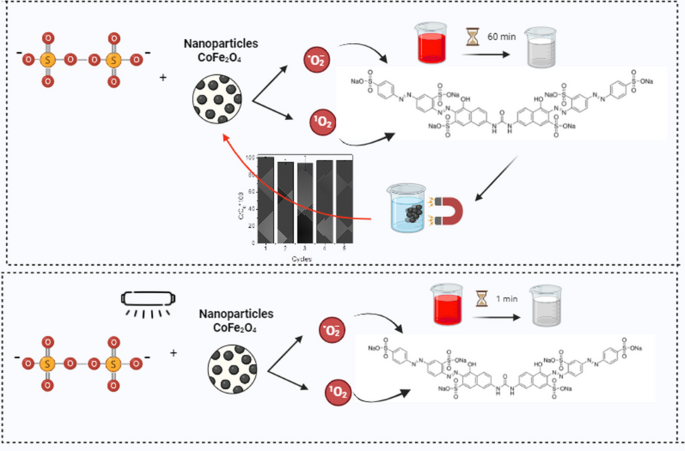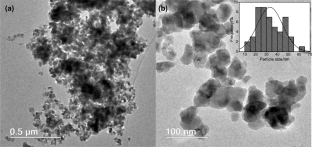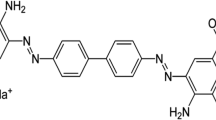Abstract
Azo dyes, widely used in the textile industry, contribute to effluents with significant organic content. Therefore, the aim of this work was to synthesize cobalt ferrite (CoFe2O4) using the combustion method and assess its efficacy in degrading the azo dye Direct Red 80 (DR80). TEM showed a spherical structure with an average size of 33 ± 12 nm. Selected area electron diffraction and XRD confirmed the presence of characteristic crystalline planes specific to CoFe2O4. The amount of Co and Fe metals were determined by ICP-OES, indicating an n(Fe)/n(Co) ratio of 2.02. FTIR exhibited distinct bands corresponding to Co–O (455 cm−1) and Fe–O (523 cm−1) bonds. Raman spectroscopy detected peaks associated with octahedral and tetrahedral sites. For the first time, the material was applied to degrade DR80 in an aqueous system, with the addition of persulfate. Consistently, within 60 min, these trials achieved nearly 100% removal of DR80, even after the material had undergone five cycles of reuse. The pseudo-second-order model was found to be the most fitting model for the experimental data (k2 = 0.07007 L mg−1 min−1). The results strongly suggest that degradation primarily occurred via superoxide radicals and singlet oxygen. Furthermore, the presence of UV light considerably accelerated the degradation process (k2 = 1.54093 L mg−1 min−1). The material was applied in a synthetic effluent containing various ions, and its performance consistently approached 100% in the photo-Fenton system. Finally, two degradation byproducts were identified through HPLC–MS/MS analysis.
Graphical Abstract












Similar content being viewed by others
Data Availability
Data supporting this study are included within the article and/or supporting materials.
References
Al-Anazi A, Abdelraheem WH, Han C, Nadagouda MN, Sygellou L, Arfanis MK, Falaras P, Sharma VK, Dionysiou DD (2018) Cobalt ferrite nanoparticles with controlled composition-peroxymonosulfate mediated degradation of 2-phenylbenzimidazole-5-sulfonic acid. Appl Catal B 221:266–279. https://doi.org/10.1016/J.APCATB.2017.08.054
Barale M, Mansour C, Carrette F, Pavageau EM, Catalette H, Lefèvre G, Fedoroff M, Cote G (2008) Characterization of the surface charge of oxide particles of PWR primary water circuits from 5 to 320 °C. J Nucl Mater 381(3):302–308. https://doi.org/10.1016/J.JNUCMAT.2008.09.003
Barua S, Miah S, Mahmud MN, Rahman IMM (2023) Isolation and identification of naturally occurring textile effluent-degrading bacteria and evaluation of their ability to inhibit potentially toxic elements. Results in Engineering 17:100967. https://doi.org/10.1016/j.rineng.2023.100967
Bertagi L, Basilio A, & Peralta-Zamora P (2021) Aplicações ambientais de persulfato: remediação de águas subterrâneas e solos contaminados. Química Nova. https://doi.org/10.21577/0100-4042.20170769
Bhinge GA, Dakave SS, Teli AD, Kengar NN, Bhosale AK, Yadav SC, & Kanamadi CM (2023) Electrocatalytic properties of CoFe2O4 synthesized by sol-gel route. Mater Today Proc. https://doi.org/10.1016/J.MATPR.2023.01.236
Bi J, Lin C, Lu D, Chen A, Meng X (2022) Exchange coupled CoFe2O4/CoFe composites for enhanced microwave absorption properties by in-situ hydrothermal reduction. J Phys Chem Solids 164:110624. https://doi.org/10.1016/j.jpcs.2022.110624
Borges ACP, Onwudili JA, Andrade HMC, Alves CT, Ingram A, Vieira de Melo SAB, Torres EA (2019) Catalytic supercritical water gasification of eucalyptus wood chips in a batch reactor. Fuel 255:115804. https://doi.org/10.1016/j.fuel.2019.115804
Brazil (2011) Ministério do Meio Ambiente (MMA). Conselho Nacional do Meio Ambiente (CONAMA). Resolution No. 430, of 05/15/2011. Provides for the conditions and standards for effluent discharge. https://www.legisweb.com.br/legislacao/?id=114770
Cai C, Kang S, Xie X, Liao C, Duan X, Dionysiou DD (2020) Efficient degradation of bisphenol A in water by heterogeneous activation of peroxymonosulfate using highly active cobalt ferrite nanoparticles. J Hazard Mater 399:122979. https://doi.org/10.1016/j.jhazmat.2020.122979
Chen N, Lee D, Kang H, Cha D, Lee J, Lee C (2022) Catalytic persulfate activation for oxidation of organic pollutants: a critical review on mechanisms and controversies. J Environ Chem Eng 10(3):107654. https://doi.org/10.1016/j.jece.2022.107654
Cristiano E, Hu Y-J, Siegfried M, Kaplan D, Nitsche H (2011) A comparison of point of zero charge measurement methodology. Clays Clay Miner 59(2):107–115. https://doi.org/10.1346/CCMN.2011.0590201
de Oliveira JS, Da Silveira Salla J, Kuhn RC, Jahn SL, & Foletto EL (2018) Catalytic ozonation of melanoidin in aqueous solution over CoFe2O4 catalyst. Mater Res, 22(1). https://doi.org/10.1590/1980-5373-MR-2018-0405
Dey C, Nandi M, Goswami MM (2023) pH dependent enhanced synchronous photocatalytic removal of cationic and anionic dyes by CoFe2O4 magnetic nanoparticles. J Mol Struct 1277:134859. https://doi.org/10.1016/j.molstruc.2022.134859
Hafeez MA, Singh BK, Yang SH, Kim J, Kim B, Shin Y, Um W (2023) Recent advances in Fenton-like treatment of radioactive ion exchange resins. Chemical Engineering Journal Advances 14:00461, 1. https://doi.org/10.1016/J.CEJA.2023.100461
Harichandran G, Prasad S (2016) SonoFenton degradation of an azo dye, Direct Red. Ultrason Sonochem 29:178–185. https://doi.org/10.1016/j.ultsonch.2015.09.005
Hassani A, Çelikdağ G, Eghbali P, Sevim M, Karaca S, Metin Ö (2018) Heterogeneous sono-Fenton-like process using magnetic cobalt ferrite-reduced graphene oxide (CoFe2O4-rGO) nanocomposite for the removal of organic dyes from aqueous solution. Ultrason Sonochem 40:841–852. https://doi.org/10.1016/J.ULTSONCH.2017.08.026
Holkar CR, Jadhav AJ, Pinjari DV, Mahamuni NM, Pandit AB (2016) A critical review on textile wastewater treatments: possible approaches. J Environ Manage 182:351–366. https://doi.org/10.1016/J.JENVMAN.2016.07.090
Hosny NM, Hazem A, Moalla SMN (2022) Synthesis, characterization and analytical applications of cobalt ferrite nanoparticles. Chemical Data Collections 42:100948. https://doi.org/10.1016/j.cdc.2022.100948
House DA (1962) Kinetics and mechanism of oxidations by peroxydisulfate. Chem Rev 62(3):185–203. https://doi.org/10.1021/cr60217a001
Hu P, Long M (2016) Cobalt-catalyzed sulfate radical-based advanced oxidation: a review on heterogeneous catalysts and applications. Appl Catal B 181:103–117. https://doi.org/10.1016/j.apcatb.2015.07.024
Jonidi Jafari A, Kakavandi B, Jaafarzadeh N, Rezaei Kalantary R, Ahmadi M, Akbar Babaei A (2017) Fenton-like catalytic oxidation of tetracycline by AC@Fe3O4 as a heterogeneous persulfate activator: adsorption and degradation studies. J Ind Eng Chem 45:323–333. https://doi.org/10.1016/j.jiec.2016.09.044
Kalpanadevi K, Sinduja CR, Manimekalai R (2014) A facile thermal decomposition route to synthesise CoFe2O 4 nanostructures. Mater Sci-Poland 32(1):34–38. https://doi.org/10.2478/s13536-013-0153-1
Khandekar MS, Kambale RC, Patil JY, Kolekar YD, Suryavanshi SS (2011) Effect of calcination temperature on the structural and electrical properties of cobalt ferrite synthesized by combustion method. J Alloy Compd 509(5):1861–1865. https://doi.org/10.1016/J.JALLCOM.2010.10.073
Kharisov BI, Dias HVR, Kharissova OV (2019) Mini-review: Ferrite nanoparticles in the catalysis. Arab J Chem 12(7):1234–1246. https://doi.org/10.1016/j.arabjc.2014.10.049
Lee Y-L, Kim H-Y, Kim K-J, Hong G-R, Shim J-O, Ju Y-W, Roh H-S (2022) Nanofiber structured oxygen defective CoFe2O4- catalyst for the water-gas shift reaction in waste-to-hydrogen processes. Int J Hydrogen Energy 47(72):30950–30958. https://doi.org/10.1016/j.ijhydene.2021.12.175
Li R, Jin X, Megharaj M, Naidu R, Chen Z (2015) Heterogeneous Fenton oxidation of 2,4-dichlorophenol using iron-based nanoparticles and persulfate system. Chem Eng J 264:587–594. https://doi.org/10.1016/J.CEJ.2014.11.128
Liu J, Meng R, Li J, Jian P, Wang L, Jian R (2019) Achieving high-performance for catalytic epoxidation of styrene with uniform magnetically separable CoFe2O4 nanoparticles. Appl Catal B 254:214–222. https://doi.org/10.1016/j.apcatb.2019.04.083
Liu L, Mi H, Zhang M, Sun F, Zhan R, Zhao H, He S, Zhou L (2021) Efficient moxifloxacin degradation by CoFe2O4 magnetic nanoparticles activated peroxymonosulfate: kinetics, pathways and mechanisms. Chem Eng J 407:127201. https://doi.org/10.1016/j.cej.2020.127201
Liu Z, Ren X, Duan X, Sarmah AK, Zhao X (2023) Remediation of environmentally persistent organic pollutants (POPs) by persulfates oxidation system (PS): a review. Sci Total Environ 863:160818. https://doi.org/10.1016/J.SCITOTENV.2022.160818
Long X, Feng C, Ding D, Chen N, Yang S, Chen H, Wang X, Chen R (2021a) Oxygen vacancies-enriched CoFe2O4 for peroxymonosulfate activation: the reactivity between radical-nonradical coupling way and bisphenol A. J Hazard Mater 418:126357. https://doi.org/10.1016/J.JHAZMAT.2021.126357
Long X, Yang S, Qiu X, Ding D, Feng C, Chen R, Tan J, Wang X, Chen N, Lei Q (2021b) Heterogeneous activation of peroxymonosulfate for bisphenol A degradation using CoFe2O4 derived by hybrid cobalt-ion hexacyanoferrate nanoparticles. Chem Eng J 404:127052. https://doi.org/10.1016/J.CEJ.2020.127052
Maharana J, Pandey S, Dhal NK (2022) A brief overview of the degradation of cyanides and phenols in the environment with reference to the coke oven industry discharge. Geomicrobiol J 39(7):619–630. https://doi.org/10.1080/01490451.2022.2045648
Martinez-Vargas S, Valle-Ascencio L, Mtz-Enriquez AI, Glez-Rosas AJ, Vázquez-Hipólito V, Mijangos-Ricardez OF, López-Luna J (2021) As(III) adsorption on co-precipitated cobalt substituted ferrite nanoparticles. J Magn Magn Mater 539:168389. https://doi.org/10.1016/j.jmmm.2021.168389
Miran W, Rasool K, Nawaz M, Kadam A, Shin S, Heo J, Jang J, Sung Lee D (2016) Simultaneous electricity production and Direct Red 80 degradation using a dual chamber microbial fuel cell. Desalin Water Treat 57(19):9051–9059. https://doi.org/10.1080/19443994.2015.1049410
Mishra S, Sahoo SS, Debnath AK, Muthe KP, Das N, Parhi P (2020) Cobalt ferrite nanoparticles prepared by microwave hydrothermal synthesis and adsorption efficiency for organic dyes: isotherms, thermodynamics and kinetic studies. Adv Powder Technol 31(11):4552–4562. https://doi.org/10.1016/J.APT.2020.10.001
Mmelesi OK, Masunga N, Kuvarega A, Nkambule TT, Mamba BB, & Kefeni KK (2021) Cobalt ferrite nanoparticles and nanocomposites: photocatalytic, antimicrobial activity and toxicity in water treatment. In: Materials Science in Semiconductor Processing (Vol. 123). Elsevier Ltd. https://doi.org/10.1016/j.mssp.2020.105523
Mo Y, Zhang X (2024) Insights into the mechanism of multiple Cu-doped CoFe2O4 nanocatalyst activated peroxymonosulfate for efficient degradation of Rhodamine B. J Environ Sci 137:382–394. https://doi.org/10.1016/J.JES.2022.12.003
Murugesan C, Perumal M, Chandrasekaran G (2014) Structural, dielectric and magnetic properties of cobalt ferrite prepared using auto combustion and ceramic route. Physica B 448:53–56. https://doi.org/10.1016/J.PHYSB.2014.04.055
Nawaz M, Miran W, Jang J, Lee DS (2017) Stabilization of Pickering emulsion with surface-modified titanium dioxide for enhanced photocatalytic degradation of Direct Red 80. Catal Today 282:38–47. https://doi.org/10.1016/j.cattod.2016.02.017
Pan X, Yan L, Li C, Qu R, Wang Z (2017) Degradation of UV-filter benzophenone-3 in aqueous solution using persulfate catalyzed by cobalt ferrite. Chem Eng J 326:1197–1209. https://doi.org/10.1016/j.cej.2017.06.068
Prakash AA, Sathishkumar K, AlSalhi MS, Devanesan S, Mani P, Kamala-Kannan S, Vijayanand S, Rajasekar A (2022) Integrated approach of photo-assisted electrochemical oxidation and sequential biodegradation of textile effluent. Environ Pollut 307:119412. https://doi.org/10.1016/J.ENVPOL.2022.119412
Puiatti GA, de Carvalho JP, de Matos AT, Lopes RP (2022) Green synthesis of Fe0 nanoparticles using Eucalyptus grandis leaf extract: characterization and application for dye degradation by a (Photo)Fenton-like process. J Environ Manage 311:114828. https://doi.org/10.1016/J.JENVMAN.2022.114828
Ramos MDN, Santana CS, Velloso CCV, da Silva AHM, Magalhães F, Aguiar A (2021) A review on the treatment of textile industry effluents through Fenton processes. Process Saf Environ Prot 155:366–386. https://doi.org/10.1016/j.psep.2021.09.029
Robles JO, Regalbuto JR (2004) The engineering of Pt/carbon catalyst preparation for 9 application on proton exchange fuel cell membrane [University of Illinois at Chicago]. https://api.semanticscholar.org/CorpusID:46982313
Rodrigues de Almeida EJ, Christofoletti Mazzeo DE, Deroldo Sommaggio LR, Marin-Morales MA, Rodrigues de Andrade A, Corso CR (2019) Azo dyes degradation and mutagenicity evaluation with a combination of microbiological and oxidative discoloration treatments. Ecotoxicol Environ Saf 183:109484. https://doi.org/10.1016/J.ECOENV.2019.109484
Şahinkaya S (2013) COD and color removal from synthetic textile wastewater by ultrasound assisted electro-Fenton oxidation process. J Ind Eng Chem 19(2):601–605. https://doi.org/10.1016/j.jiec.2012.09.023
Saravanan A, Deivayanai VC, Kumar PS, Rangasamy G, Hemavathy RV, Harshana T, Gayathri N, Alagumalai K (2022) A detailed review on advanced oxidation process in treatment of wastewater: mechanism, challenges and future outlook. Chemosphere 308:136524. https://doi.org/10.1016/j.chemosphere.2022.136524
Shi B, Wang Y, Ahmed I, Zhang B (2022) Catalytic degradation of refractory phenol sulfonic acid by facile, calcination-free cobalt ferrite nanoparticles. J Environ Chem Eng 10(3):107616. https://doi.org/10.1016/j.jece.2022.107616
Sun K, Yuan D, Liu Y, Song Y, Sun Z, Liu R (2020) Study on the efficiency and mechanism of Direct Red 80 dye by conventional ozonation and peroxone (O 3 /H 2 O 2) treatment. Sep Sci Technol 55(17):3175–3183. https://doi.org/10.1080/01496395.2019.1670209
Tatarchuk T, Danyliuk N, Kotsyubynsky V, Shumskaya A, Kaniukov E, Ghfar AA, Naushad Mu, Shyichuk A (2022) Eco-friendly synthesis of cobalt-zinc ferrites using quince extract for adsorption and catalytic applications: an approach towards environmental remediation. Chemosphere 294:133565. https://doi.org/10.1016/j.chemosphere.2022.133565
Thangaraj S, Bankole PO, Sadasivam SK (2021) Microbial degradation of azo dyes by textile effluent adapted, Enterobacter hormaechei under microaerophilic condition. Microbiol Res 250:126805. https://doi.org/10.1016/J.MICRES.2021.126805
Thi Thanh Le D, Long NDH, Thi Xuan C, Van Toan N, Hung CM, Van Duy N, Thi Theu L, Dinh VA, Hoa ND (2023) Porous CoFe2O4 nanorods: VOC gas-sensing characteristics and DFT calculation. Sens Actuators, B Chem 379:133286. https://doi.org/10.1016/J.SNB.2023.133286
Venâncio JPF, Rodrigues CSD, Nunes OC, Madeira LM (2022) Application of iron-activated persulfate for municipal wastewater disinfection. J Hazard Mater 426:127989. https://doi.org/10.1016/J.JHAZMAT.2021.127989
Wang L, Jiang H, Wang H, Show PL, Ivanets A, Luo D, Wang C (2022) MXenes as heterogeneous Fenton-like catalysts for removal of organic pollutants: a review. J Environ Chem Eng 10(6):108954. https://doi.org/10.1016/j.jece.2022.108954
Wu X, Kim J-H (2022) Outlook on single atom catalysts for persulfate-based advanced oxidation. ACS ES&T Engineering 2(10):1776–1796. https://doi.org/10.1021/acsestengg.2c00187
Wu L, Zhang Q, Hong J, Dong Z, Wang J (2019) Degradation of bisphenol A by persulfate activation via oxygen vacancy-rich CoFe2O4–x. Chemosphere 221:412–422. https://doi.org/10.1016/j.chemosphere.2019.01.049
Xiao G, Xu T, Faheem M, Xi Y, Zhou T, Moryani HT, Bao J, Du J (2021) Evolution of singlet oxygen by activating peroxydisulfate and peroxymonosulfate: a review. Int J Environ Res Public Health 18(7):3344. https://doi.org/10.3390/ijerph18073344
Xie Q, Zhu Y, Xian H, Chen Q, Liu C, Wu F, Liang X, Zhu R (2023) The complex heterogeneous Fenton reactivity of transition metal-doped ferrihydrite: insight from the structural variation and pathway of H2O2 activation. Appl Surf Sci 622:156913. https://doi.org/10.1016/J.APSUSC.2023.156913
Yang Z, Li Y, Zhang X, Cui X, He S, Liang H, Ding A (2020) Sludge activated carbon-based CoFe2O4-SAC nanocomposites used as heterogeneous catalysts for degrading antibiotic norfloxacin through activating peroxymonosulfate. Chem Eng J 384:123319. https://doi.org/10.1016/J.CEJ.2019.123319
Zhang M, Hou Q, Shi Z, Yang H, Wang D, Yang J (2023) Enhanced bio-ethanol production from bamboo residues by alkali-aided Fenton reaction pretreatment and enzymatic saccharification. Ind Crops Prod 194:116339. https://doi.org/10.1016/j.indcrop.2023.116339
Acknowledgements
The authors would like to thank the Fundação Coordenação de Aperfeiçoamento de Pessoal de Nível Superior—Brazil (CAPES), Conselho Nacional de Desenvolvimento Científico e Tecnológico (CNPq, Process 312400/2021-7 and Process: 405828/2022-5), Fundação de Amparo à Pesquisa do Estado de Minas Gerais (FAPEMIG, RED-00144-22), Departments of Chemistry and Physics of the Universidade Federal de Viçosa, Microscopy Center at the Universidade Federal de Minas Gerais (http://www.microscopy.ufmg.br) and Spectrometry, sample preparation and mechanization group at the Universidade Estadual de Campinas (https://gepam.iqm.unicamp.br/facilid_tit1.htm) for providing equipment and technical support. The authors would also like to thank professors Robson Ricardo Teixeira and Kássio Ferreira Mendes and Dr. Mariana Beatriz Teixeira Diniz for elucidating the degradation byproducts by HPLC-MS/MS.
Funding
This work was supported by Fundação Coordenação de Aperfeiçoamento de Pessoal de Nível Superior—Brazil (CAPES), Conselho Nacional de Desenvolvimento Científico e Tecnológico (CNPq, Process 312400/2021–7 and Process: 405828/2022–5), and Fundação de Amparo à Pesquisa do Estado de Minas Gerais (FAPEMIG, RED-00144–22).
Author information
Authors and Affiliations
Contributions
Carmo Dias: conceptualization, methodology, investigation, formal analysis, writing—original draft, writing—review and editing; Gustavo Alves Puiatti: conceptualization, methodology, formal analysis; Noemi Cristina Silva de Souza: conceptualization, methodology, formal analysis; Eduardo Israel Pimenta de Souza: investigation; Renata Pereira Lopes: conceptualization, methodology, resources, funding acquisition, investigation, formal analysis, writing—original draft, writing—review and editing, supervision.
Corresponding author
Ethics declarations
The authors confirm that this is an original submission which has not been published previously or submitted to any other journal.
Consent to participate and publish
Informed consents were obtained from all the participants prior to the enrollment of this study. Informed consents were obtained from all the participants for publication.
Competing interests
The authors declare no competing interests.
Additional information
Responsible Editor: Guilherme Luiz Dotto
Publisher's Note
Springer Nature remains neutral with regard to jurisdictional claims in published maps and institutional affiliations.
Highlights
• Cobalt ferrite was used to degrade DR80 through Fenton-like process.
• In the presence of UV light, the reaction reaches 100% degradation in less than 1 min.
• The degradation demonstrated versatility across a wide pH range.
• The material can be easily removed by magnetization and reused in various cycles.
• The main degradation species involve the radicals 1O2 and O2•–.
Supplementary Information
Below is the link to the electronic supplementary material.
Rights and permissions
Springer Nature or its licensor (e.g. a society or other partner) holds exclusive rights to this article under a publishing agreement with the author(s) or other rightsholder(s); author self-archiving of the accepted manuscript version of this article is solely governed by the terms of such publishing agreement and applicable law.
About this article
Cite this article
do Carmo Dias, G., de Souza, N.C.S., de Souza, E.I.P. et al. Enhanced degradation of Direct Red 80 dye via Fenton-like process mediated by cobalt ferrite: generated superoxide radicals and singlet oxygen. Environ Sci Pollut Res 31, 28025–28039 (2024). https://doi.org/10.1007/s11356-024-32976-w
Received:
Accepted:
Published:
Issue Date:
DOI: https://doi.org/10.1007/s11356-024-32976-w




